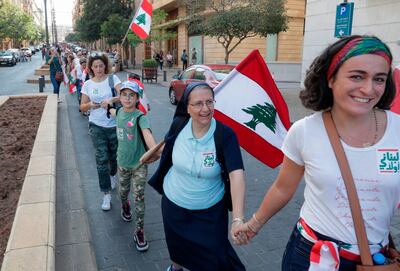They stretched out for scores of kilometres, hand in hand forming a human chain of thousands along the Lebanese coast.
Sunday marked the 11th consecutive day of mass protests in Lebanon, an uprising of anger against years of inequality, government inefficiency and corruption that has led to an economic crisis and worsening living standards.
Julie Bou Nassif, the woman behind the plan to form a human chain linking the north to the south, said that while they did not have exact numbers, she believes tens of thousands took part in forming the line that stretched more than 170 kilometres.
"Not only is it a success but it's just starting to sink in," Ms Bou Nassif told The National a few hours after the event finished.
“In Hasbaya [in the south-east] we just heard from the news that they joined, with no one calling us. It was a total success.”
People were supposed to start lining up about 1pm, but she said in central Beirut they had to start early because people arrived hours ahead of schedule.
“We didn’t expect this but it was a very good thing as we had time to spread people out,” said Ms Bou Nassif, a high school history teacher and a lecturer at Universite Saint Joseph in Beirut.
“In some towns they didn’t have the numbers but they came from other areas to help out, people from Jbeil and Jounieh [north of Beirut], to fill in the gaps.”
The chain idea came when her sister returned from the south in the first few days after the mass rallies began on October 17.
“It started at home on the balcony and we thought maybe a few friends and a few thousand in Beirut would come,” Ms Bou Nassif said.
She said a Facebook event last Wednesday for the chain soon went viral.
It was picked up by local bloggers and the Lebanese media, and by the next day she was receiving dozens of calls from people all over the country asking how they could get involved and why their towns were not included in the route.
“We had hundreds of volunteers by Friday night, and we divided them by region so we knew who was handling the regions," Ms Bou Nassif said.
"it’s really through WhatsApp and Facebook and Interstream that we organised.
Cars passing the human chain in Beirut honked horns and shouted support. Every 10 minutes or so a van with speakers strapped to the top blaring patriotic songs passed by, to cheers from the crowd and more honks from cars.
Mopeds sped up and down, taking pictures and video and keeping people informed of where gaps remained, if they needed more people down the line.
“Come on, all the way, hold hands,” one woman shouted as people spread out along highways to fill the gaps.
Senior politicians have been largely silent since Hezbollah leader Hassan Nasrallah spoke on Friday.
The government scrambled to take action when the protests broke out, with Prime Minister Saad Hariri announcing a 72-hour window for all the major parties represented in his Cabinet to agree on a package of reforms to fix the country’s ills.
Despite Cabinet approving the bill last Monday, the protests have not diminished.
Through the heart of Beirut on Sunday, people with Lebanese flags draped over their shoulders and flags painted on their faces strung out.
Jihan and Hala, who run their own business in the village of Ain Saadeh just above Beirut, said they were on the streets to make a change.
“We’re here for a new future, a brighter future for our kids and we want a new Lebanon,” Jihan said.
“It [the human chain] is amazing, it’s something new for Lebanon. Everyone is so motivated today to do it.”
She said that she and Hala went to the protests in Beirut four or five times a week, depending on their children.
Jihan said the movement had gone on too long to be ignored and “of course” they had the energy to keep up pressure on the government.
Paula, a student from Beirut, joined the chain where the highway runs between Beirut’s Souks and the waterfront.
Paula said she had come to support the movement but was not sure how much impact the mass protests could have.
"I'm here to make a point, to be with everyone, to be united with the rest of the people," she told The National.
“I hope the movement lasts. I’m not that optimistic but I want to change the system, maybe, stop corruption.
"I’m not that sure how it’s going to happen, if it’s going to happen, but I guess that now our generation is more included in what’s going on, more involved in politics, so it still had a good effect.”
Kareem, 19, also a student in Beirut, said he was more hopeful.
“People are waking up,” he said of the past 11 days. “It’s amazing to see.
"I really thought when Hariri spoke, people would say, ‘OK, we have what we want’ and go home, but they didn’t. I’m happy to see it.”
Kareem said the movement changed how he saw the country and broke down barriers between communities.
“Now you can see that people are more united," he said. "We don’t judge anyone from their culture or their religion, everyone is here together on the streets.
"It’s not any more Christians or Muslims. We’re all one, we’re all Lebanon.”
Asked if this would make a difference when the political statements from traditional parties still include sectarian overtones, Kareem was clear.
"Let them talk, let them point the finger. We’re going to win," he said. "In the end, the citizens put them in power and so we can take the power from them.”









